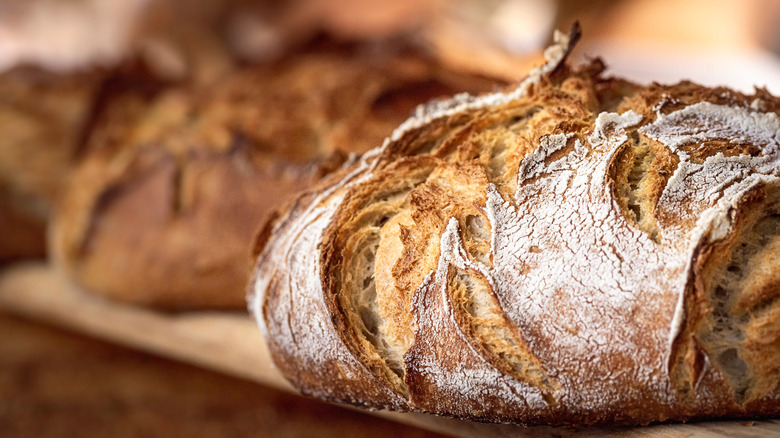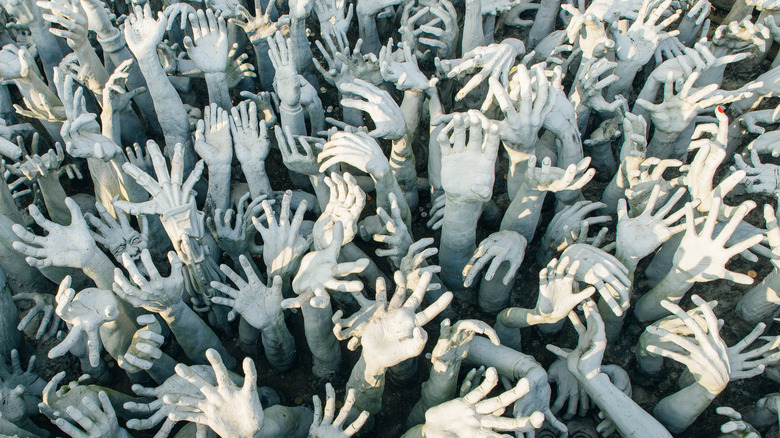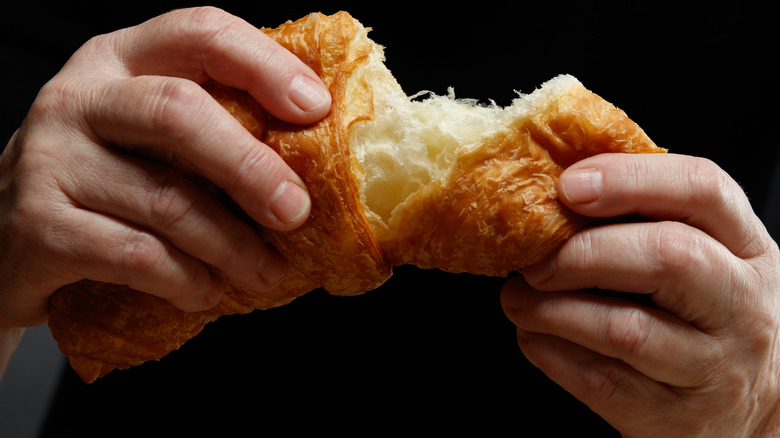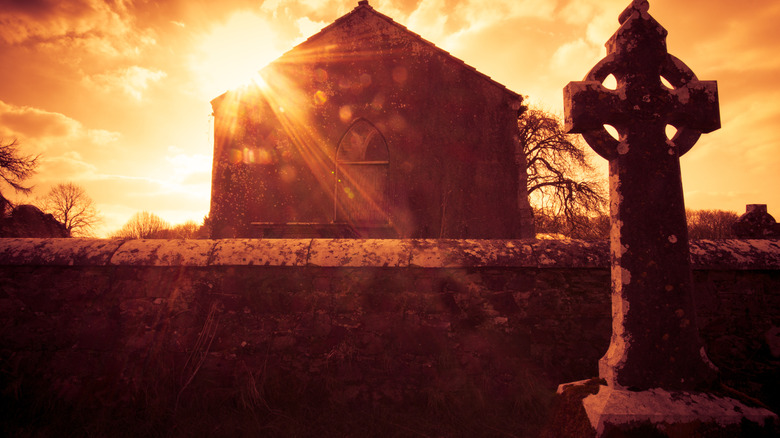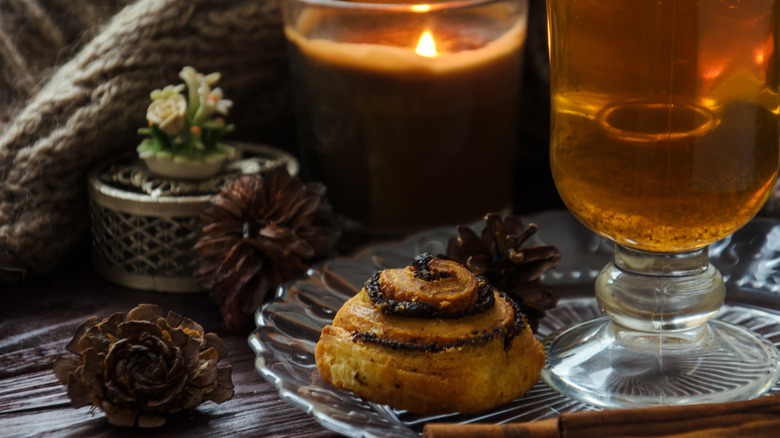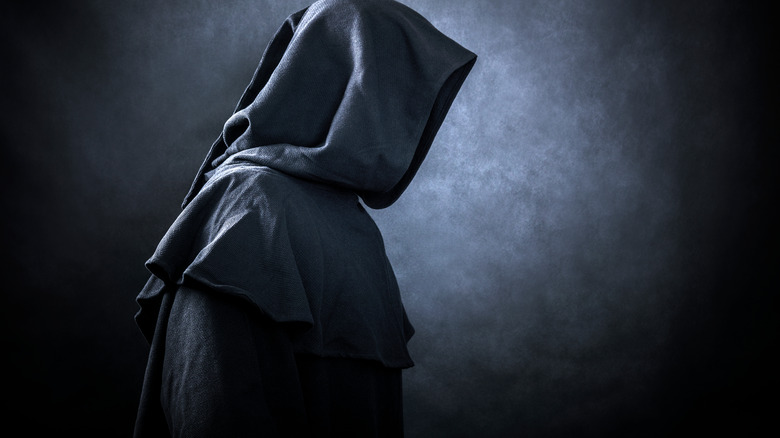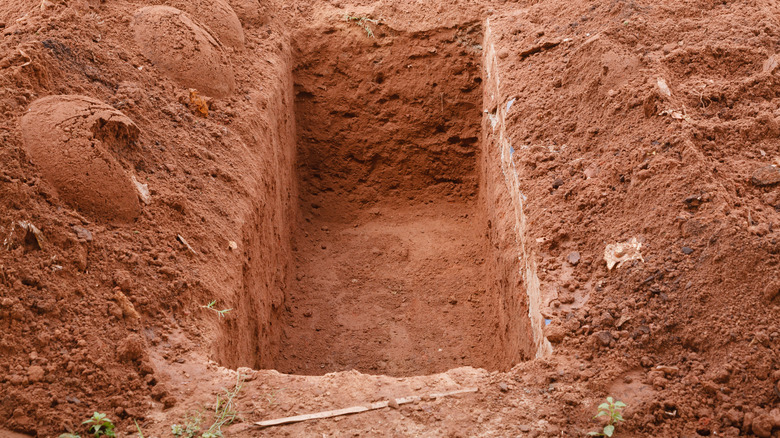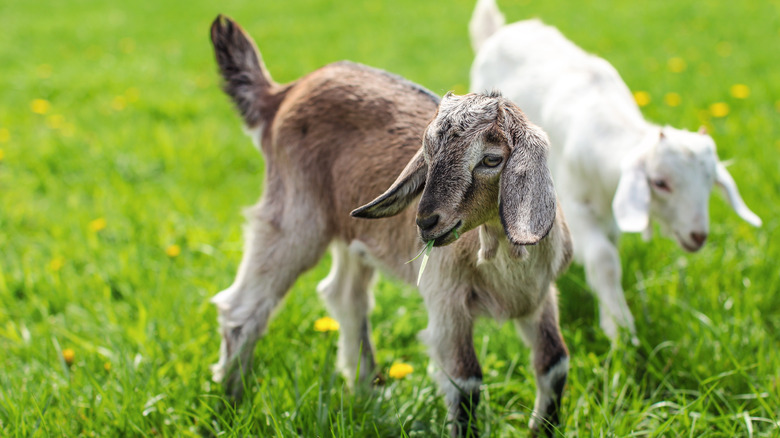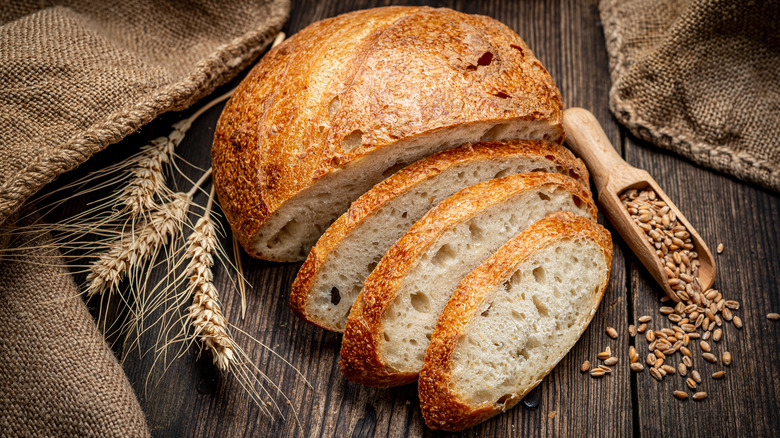The Strange History Of Sin-Eaters
While religion can provide a sense of meaning and the belief that life in this world isn't all that's out there, it's no secret that it also provides a blueprint for how everyone should be living their day-to-day lives. Sinning is a huge deal, and here's the weird thing: No one can even decide just when it got a first mention in the Bible.
There are a few candidates: Biblical Archaeology says the first sinners could be arguably Adam and Eve with that whole forbidden fruit thing, but throughout antiquity, it was Cain who shouldered that burden with the murder of his brother. Answers in Genesis says there's still another possibility, and that's the idea that Satan/Lucifer was the first sinner. Whoever the first was, ZME Science says humankind has been dealing with it ever since — and they've had numerous ways of cleansing the soul. The outlet suggests that the first person to offer themselves up to wipe away the world's sins was Jesus Christ, and it even goes as far as to suggest that he may have been the first sin-eater ... even though Christianity on a whole was absolutely not on board with this particular practice.
So, what was it? It's a very old tradition that sees one person shouldering the burden of the sins of others, and it's even more heartbreaking than it sounds.
It was the solution to a very Christian problem
In order to talk about sin-eaters, we have to back up a bit first and talk about just why they were such a big deal.
St. Paul, Minnesota pastor Ryan Griffith says (via Desiring God) that the idea of confessing sins forms the basis of a person's relationship with God and allows them to be forgiven — that's what gets the good people into heaven. He also says that God already knows what all our sins are, and it's our acknowledgment of them and desire to do better that's the important part. In Luke 11:4, Christ talks about just how important confession is, and it's basically his sacrifice that gives people the chance at forgiveness post-confession.
That's all pretty straightforward, but the real world is often anything but straightforward. Death is a sneaky, sneaky guy who could be lurking around any corner, and even if a person attends church and confession regularly, there's a pretty good chance that they will die carrying unconfessed sins. That, says History Collection, is what purgatory is for, but who wants to spend time there when you can get right to the good stuff?
And this is where the sin-eater comes in. These were people who were believed to be able to draw the sin out of a recently deceased person's soul and take it upon themselves to allow that person to go straight to heaven.
The sin-eater subjected himself to eternal damnation
Different parts of the world have long had different ways of ridding people of their sins. The ancient Aztecs, for example, had a goddess that would appear to a person as they died and relieve them of their sins as long as they confessed. ZME Science says this is similar to what was believed in ancient Egypt and Greece, but let's hop over to the British Isles. There, one way of ridding someone who had died of the burden of sin was to call the sin-eater. It was a tradition that was particularly common in the 18th and 19th centuries in Scotland, Wales, and the areas bordering Wales, and it's eerie stuff.
The sin-eater would place bread on the chest of the corpse and then sit beside the body. The belief was that the bread would absorb all of those unconfessed sins, and when the sin-eater consumed the bread, they would take on those sins as their own. Since they wouldn't know what the sins were, they wouldn't be able to confess themselves, and the act essentially condemned them to eternal damnation.
Sin-eaters, says Atlas Obscura, would proclaim "the ease and rest of the soul departed," and what would they get for doing this? They were paid, but the average — as far as historians can tell — is about 4 pence per body. In today's money, that's just a few bucks.
There are few first-hand accounts
Megan Campisi did an impressive amount of research into this little-studied and even more rarely talked about phenomenon for her debut novel, "The Sin Eater."
It's so obscure, in fact, that she found there were few first-hand accounts from those who had seen a sin-eater at work. One of them was published in 1852 by Matthew Moggridge in a report presented to the Cambrian Archaeological Association. He wrote (via Pan Macmillan): "When a person died, the friends sent for the sin-eater of the district, who on his arrival placed a plate of salt on the breast of the defunct, and upon the salt a piece of bread. He then muttered an incantation over the bread, which he finally ate, thereby eating up all the sins of the deceased." Upon finishing the ritual, the sin-eater immediately left.
Campisi had a few ideas about why there were so few accounts of sin-eaters, and it basically boiled down to the fact that no one wanted it to be known that they had associated with one. The result is that almost everything that's known about them and their custom comes from just a few sources, although the practice was undoubtedly much more widespread than historical records suggest.
It's not entirely clear where and when the tradition started
No one really knows just how, when, or where the tradition of sin-eaters started, but written references to sin-eaters dating back to the 1680s already call the tradition an old one, says Atlas Obscura. History remembers the last one, but the early ones? That's iffy. There's one theory that suggests it grew out of ancient pagan traditions, and History Collection reports that some theorize it existed in that strange realm between pagan and Christian. Is it a pagan tradition adapted to exist in the world of Christianity and save the sinners no matter what they believe? Maybe.
Scholar Ruth Richardson — who wrote "Death, Dissection, and the Destitute" — has another theory. Go back to the Middle Ages, and you'll find a custom where the nobility handed out food to the poor on the occasion of someone's death. The idea was that the food was given as an appeal to ask the poor masses to pray for the person who had recently died to see if they could help guarantee that their journey to the afterlife was a peaceful one.
And still others suggest it developed among the offshoots of Catholicism as a way of kind of giving Christianity's heavy hitter the big ol' middle finger. The Catholic Church didn't approve of the idea of sin-eaters — forgiving sins was supposed to be the prerogative of the divine — and it may have been seen as a way to find agency over the spiritual realm.
It's not the only tradition that involved eating food off the dead
The idea of eating something that's been sitting around on a dead body might make 21st-century stomachs queasy, but it's worth mentioning that it's not a super weird idea as far as historical funeral traditions go. As Vice notes, it's only recently that people started dying in hospitals and other clinical settings, like nursing homes. Prior to our modern era, the ill and the elderly would have been cared for at home and likely would have died there, too. People were a lot more accustomed to getting up close and personal with death, and with death often came food.
Go back to the Victorian era, there were funeral biscuits alongside sin-eaters. They would be handed out during memorial services, and they were a huge industry. But actually eating off the corpse? In the Middle Ages, some areas of Europe — particularly in and around Germany — observed a tradition called a corpse cake. Pastry dough would be mixed and left to rise ... while sitting on the chest of the dead. It would be baked and eaten by those who came to mourn the deceased, and the idea was that as the dough rose, it absorbed some of the best and most honorable characteristics of the dead, which were absorbed by the mourners who ate the cake. It's incredibly similar to the idea of the sin-eater, only it's passing on good qualities instead of sins.
Sin-eaters were outcasts, eternally damned, and hunted by the church
Being a sin-eater was a pretty awful occupation, even if you could get past eating bread off the dead. Even for an atheist who might think it's a nifty way to make some extra coin with minimal work, it would have been the furthest thing from a dream job.
As Atlas Obscura explains, there were plenty of people who did believe in the occupation. And given that the sin-eater was taking the sins of the dead and putting them squarely on their own shoulders, it was believed that with each piece of bread, they became more and more evil. They were universally reviled, pushed to the edges of town and the fringes of society. Even when they were called to a home to do their job, the sin-eaters were often beaten and thrown out the door the moment they consumed the sins, lest the house and mourners be contaminated by their presence (via Vice).
They weren't just hated by their inevitable customers, either. Given that they were going against the doctrine of the church, they were seen as heretics. History Collection says that if the church found a sin-eater, they could expect anything from ex-communication to torture and execution. That meant they needed to be extremely careful about when and where they did their job, and this all also meant it was only the most desperate of people — or, those who had already committed unforgivable sins — who turned to sin-eating.
The idea of paying your way into heaven is a big one
The bottom line to the existence of the sin-eater is the idea that someone can pay their way into heaven. If that sounds like a not-very-Christian sort of thing to do, let's talk about how the church was actually doing the same thing.
According to World History, the church had been selling indulgences for a long time before people finally said enough was enough — that's not how sinning and forgiveness should work at all. It started with something called the "treasury of the Church," which was basically a bank for goodness. People could, in theory, buy an indulgence with the promise to perform good deeds to help keep the Goodness Bank topped up, and in return, they'd get a speedier trip past the Pearly Gates.
The earliest indulgences go back to the mid-3rd century when Christians who were forced to deny their faith in the face of Roman persecution could buy their way back in. By 1400, selling indulgences had become a major source of income, and there were two schools of thought. One believed there was nothing wrong with padding the coffers this way, while the other said the rich shouldn't be able to do whatever the heck they wanted and pay to have their sins removed.
History Collection suggests that part of the church's hatred of sin-eaters is that they were cutting into their profit margin by also being paid to remove sins.
It may have spread to the US
Folklore devotees may have heard the rumor that the practice of sin-eating spread to the U.S. What's the story, and how true is it? While researching her book, "The Sin Eater," Megan Campisi looked into the likelihood that there were American sin-eaters. She told Pan Macmillan that she reached out to the Appalachian State University and the Western North Carolina Historical Association and asked them about the stories of Welsh immigrants bringing the practice of sin-eating across the Atlantic with them.
Campisi says that they — along with a handful of research librarians from the localities that would have been the perfect place for these sin-eaters to establish themselves alongside their old-world countrymen — found little evidence of American sin-eaters. Any of the few references were second-hand and further removed from the source. But while Campisi says she was disappointed not to find more, it's still worth noting that even original sin-eaters left behind little in the way of evidence and stories of their sad lives on the outskirts of society.
There are other versions of the tradition
Bertram S. Puckle's "Funeral Customs" was written in 1926 and talks about sin-eaters, albeit briefly. He addresses it in the chapter on the wake, a tradition he says stems in part from the need for grieving friends and family to come to terms with the fact that they are no longer needed by the deceased. Puckle likened sin-eating to another one half the world away, where some groups were known to slaughter an animal on a recently dug grave, hoping that the sins of the dead person would be transferred to the animal. (He also recorded an experience with a sin-eater, but again, this is a second-hand testimony that came from Professor Evans, who was said to teach at Presbyterian College. He, interestingly, noted that the sin-eater he saw in 1825 burned the plate he ate from and the bowl he drank from after every death.)
The Takeout says that while sin-eating reached a high point in the 18th and 19th centuries, there's still a form of it practiced at some traditional Chinese funerals. They say that sometimes, families ask monks to perform a ritual that transfers the sins of the dead into dim sum. The dim sum is then eaten by a modern-day form of sin-eater, helping to send the spirit onward and upward.
It may have been connected to Leviticus and the scapegoat
Way back in 1931, The Irish Times published an article about the sin-eater. They'd learned that it was normal for most areas to have a dedicated sin-eater, and after giving a run-down of just what that involved, they mentioned that it's a modern extension of the Biblical idea of the scapegoat.
The scapegoat shows up in Leviticus 16:1-34, and according to My Jewish Learning, it's a passage that's commonly read for Yom Kippur. It tells the story of Aaron making amends to God, and he's given some very specific instructions. In addition to being told how to dress and prepare himself, he's also told to "take two he-goats for a sin offering and a ram for a burnt offering."
The goats were then taken before God, and it was decided that one would be slaughtered and sacrificed, and the blood was used to cleanse the meeting area. Then, a priest would touch the other goat, confess all the sins of all of the Israelites, and in doing so, they would be transferred to the goat. The scapegoat would then be sent into the wild, taking all the sins with it.
Got Questions says that the goat was then considered to be unclean, and the fate of the goat — to be driven out of society and into the wilderness — sounds a heck of a lot like the fate of the sin-eater.
The last sin-eater died in 1906
By the end of the 19th century, the practice of sin-eating was pretty much an extinct one — save a few remaining hangers-on. According to the BBC, the very last sin-eater was a man named Richard Munslow, and he died in 1906. The life of a sin-eater was the life of an outcast, so it was usually a person who was already an outsider or destitute who took up the mantle. Munslow was an exception: Before he became a sin-eater, he was a successful farmer. National Geographic investigated why he would have chosen this unlikely profession, and it's heartbreaking stuff rooted in unthinkable family tragedy.
Munslow had four children, and in 1870, three of his children fell ill and died — all in the same week. Munslow's attempt at reconciling his loss was the belief that unforgiven sins were accumulating in the village and bringing down the luck of the damned. The souls of those who weren't allowed to move on were thought to be haunting the living and causing tragedies like the ones suffered by Munslow's family, so it's believed he became a sin-eater in an attempt to free his village of the evils that walked among them.
His own sacrifice was believed to condemn him to eternal damnation, but at the same time, he passed along a sense of peace to those around him. Sin-eaters may have been viewed as increasingly evil creatures, but at the same time, they were a necessary evil.
